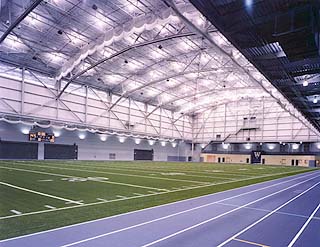|
Subscribe / Renew |
|
|
Contact Us |
|
| ► Subscribe to our Free Weekly Newsletter | |
| home | Welcome, sign in or click here to subscribe. | login |
Construction
| |
 |
September 13, 2001
Bright lights, big facility
Casne Engineering

. Photo courtesy of Carlson Architects The majority of light on the field is provided by the high-bay downlights. To create more of an outdoor feel, indirect uplighting is used to illuminate the 16-foot-deep ceiling cavity between the bottom of the roof trusses and the upper roof deck |
The lighting at the University of Washington’s new Dempsey Indoor practice facility was designed to allow athletes and coaches to see comfortably and accurately. This was accomplished by considering and controlling light levels, glare, color rendition and uniformity, and choosing the most energy-efficient light sources.
Metal halide lamps were selected for their high efficiency measured in lumens/watt, and their ability to produce “bright white” light, as measured by their superior color-rendering index.
A combination of 1000-watt direct high-bay downlights and 400-watt indirect uplights were used to achieve relatively high lighting levels on the field, and to provide uniform light levels over the entire field.
Lighting uniformity measures light level consistency between one area and adjacent areas. On a large playing field, it is important to provide good uniformity levels to ensure good perception of speed and position, which is particularly important in high-speed sports such as baseball, softball and football.
The majority of light on the field is provided by the high-bay downlights. The indirect uplighting was included in the design to illuminate the 16-foot-deep ceiling cavity between the bottom of the roof trusses and the upper roof deck. The effect creates an “outdoor” feel. The uplighting prevents the roof truss area between the high-bay downlights and the upper roof deck from being dark, which would have created a “cave” effect.
The indirect lighting further improves the uniformity of the light distribution on the field. The four-lane running track around the perimeter of the football field is lit by a combination of low-bay downlights and indirect lighting fixtures mounted on the perimeter walls.
Special attention was given to the circuiting of all lighting fixtures to avoid stroboscopic effect. By providing power to adjacent light fixtures from different phases of the electrical distribution system, the slight flicker that all high-intensity discharge lamps exhibit cannot be perceived.
Daylighting was provided with a translucent clerestory. Approximately 6,000 square feet of translucent glazing runs the length of the building on the east and west sides, 60 feet above the field. The daylighting allows indirect sunlight to be admitted to the space during the day, which saves energy, increases light levels and moves the overall color spectrum even closer to that of natural sunlight.
In the event of a power failure, quartz lights will provide illumination throughout the entire facility and at all exit points, allowing a safe and controlled evacuation. Fifteen hundred-watt quartz lights in the high-bay area over the field and 500-watt quartz lights over the running track were chosen to provide this illumination due to their “instant-on” characteristic. A 60-kilowatt emergency diesel generator is provided to power the exit lighting when the utility power isn’t available. The diesel engine generator will start automatically and switch on within ten seconds to re-light the space.
A unique approach was required for the lighting control system. Due to multiple uses of the facility and the need for flexible use, the lighting was divided into zones.
The lighting zones correspond with areas separated by athletic nets, which can be lowered to separate the field from the track and to divide the field in half. Within each zone, the direct, indirect and quartz lights can all be switched independently resulting in control of the light levels within the zone.
The light switching is accomplished with a low voltage switch station and color-coded legend map located in the facility manager’s office. These switches serve as inputs to remote programmable relay scanners, which directly control the lighting zone’s power circuits.
The light switches within the manager’s office provide positive on/off indication through red and green indicating lights.
The overall result is a lighting system that is functional, versatile and simple to operate.
Paul Crivell is the commercial department manager at Casne Engineering, where he is in charge of coordination, scheduling, design and quality assurance. Casne Engineering specializes in providing electrical engineering and consulting services in the Northwest.
Other Stories:
- NW schools spend big to play indoors
- Versatile structure is built to fit
- Husky practice building gives designers a workout
- Can’t get no liquefaction


